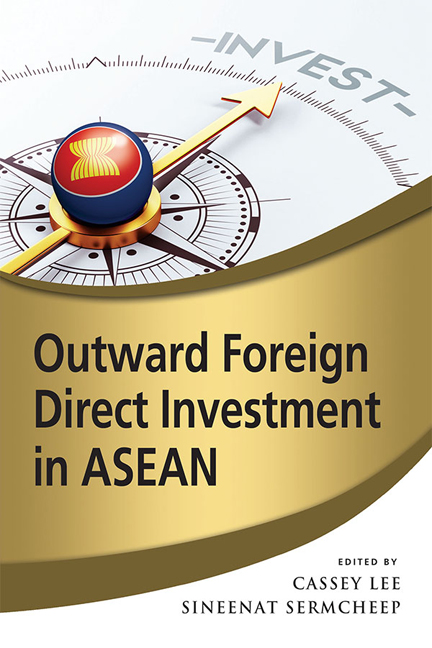Book contents
- Frontmatter
- Contents
- List of Tables
- List of Figures
- Foreword
- About the Contributors
- Introduction
- 1 The Rise of Outward Foreign Direct Investment from ASEAN
- 2 ASEAN's Outward Foreign Direct Investment
- 3 The Impact of the ASEAN Economic Community on Outward FDI in ASEAN Countries
- 4 Determinants of Singapore's Outward FDI
- 5 Outward Foreign Direct Investment from Malaysia
- 6 Indonesia's Outward Foreign Direct Investment
- 7 Factors Influencing Thailand's Outward FDI
- 8 Outward Foreign Direct Investment: The Case of Vietnam
- 9 Myanmar as a Destination for OFDI: A New ASEAN Foreign Investment Frontier
- Index
1 - The Rise of Outward Foreign Direct Investment from ASEAN
Published online by Cambridge University Press: 19 May 2017
- Frontmatter
- Contents
- List of Tables
- List of Figures
- Foreword
- About the Contributors
- Introduction
- 1 The Rise of Outward Foreign Direct Investment from ASEAN
- 2 ASEAN's Outward Foreign Direct Investment
- 3 The Impact of the ASEAN Economic Community on Outward FDI in ASEAN Countries
- 4 Determinants of Singapore's Outward FDI
- 5 Outward Foreign Direct Investment from Malaysia
- 6 Indonesia's Outward Foreign Direct Investment
- 7 Factors Influencing Thailand's Outward FDI
- 8 Outward Foreign Direct Investment: The Case of Vietnam
- 9 Myanmar as a Destination for OFDI: A New ASEAN Foreign Investment Frontier
- Index
Summary
INTRODUCTION
Over the past decade, developing economies have been actively investing abroad. This is reflected in their share of the world foreign direct investment (FDI) outflows which increased significantly from 11.87 per cent in 2000 to a record of 35 per cent in 2014 (Table 1.1). In particular, due to the surge in outward foreign direct investment (OFDI) from Asian developing economies since 2005, developing Asia became the world's largest investor region for the first time in 2014, accounting for approximately one-third of the global FDI outflows (UNCTAD 2015).
A number of countries from the Association of Southeast Asian Nations (ASEAN) have become major players in the investment arena. Even though ASEAN countries have been major recipients of FDI, they have evolved into an emerging source of investment for many developing economies, especially in the ASEAN region (ASEAN Secretariat 2013). The overall FDI outflow from ASEAN rose rapidly from US$8.97 billion in 2000 to US$56.36 billion in 2013 (Table 1.1).
Among the top source countries for OFDI, two leading investors from ASEAN — Singapore and Malaysia — made it to the 10th and the 17th rank respectively in 2014 (Table 1.2). Other major investors from East Asia are Hong Kong, Korea, Taiwan and China. The first three have long been leading global investors since the past few decades while China has become the major source of OFDI recently, with a rapid rise in overseas investment. Aside from Singapore, Malaysia and Thailand have emerged as net investors in 2007 and 2011, respectively.
This new FDI landscape in ASEAN has been shaped by many factors including the increase in mergers and acquisitions (M&As) and the rising importance of the region as a key player in the global value chain. In addition, ASEAN's outward investment has been enhanced by regional economic integration. The ASEAN Economic Community (AEC) aims to achieve a single market and production base in the region. Governments of ASEAN member states have been actively encouraging their national companies to invest abroad to take advantage of the benefits of the AEC (ASEAN Secretariat 2013).
- Type
- Chapter
- Information
- Outward Foreign Direct Investment in ASEAN , pp. 5 - 29Publisher: ISEAS–Yusof Ishak InstitutePrint publication year: 2017

